The Speed of Trust Summary – The One Thing That Matters
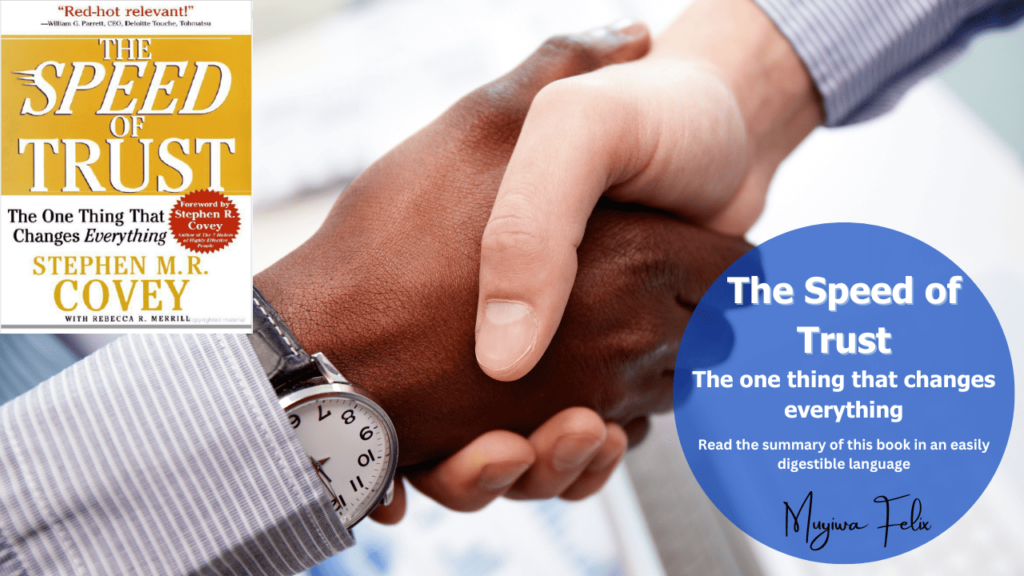
The Speed of Trust is a book by Stephen M.R Covey that generously explores the ideology that “Trust is the most important thing in every relationship. Stephen Covey
Trust is a very important factor in every relationship and any relationship that lacks or downplays it will not last. I haven’t seen the concept of trust explicitly presented in the way Stephen M.R Covey did in this book – “The Speed of Trust”.
When we talk about speed, light is often the direct comparison as a scientific fact that has been proven beyond any reasonable doubt. Without any inkling of doubt, Stephen Covey justifies how Trust is the one most important thing that can boost self-relationship, relationships with other people, and organizational relationships.
This 13-chapter, 517-page book is rich in anecdotes featuring stories from domestic environments and corporate settings persuasively establishing that trust is the most valuable currency in any endeavor that thrives on relationships.
According to Stephen,
Trust impacts us 24/7, 365 days a year. It undergirds and affects the quality of every relationship, every communication, work, project, business venture, and every effort in which we are engaged. It changes the quality of every present moment and alters the trajectory and outcome of every future moment of our lives—both personally and professionally.
You can regain trust (The speed of Trust)
“Trust, once lost, could not be easily found. Not in a year, perhaps not even in a lifetime.” – The Speed of Trust
J.E.B. Spredemann, Author of “An Unforgivable Secret”
One of the most popular notions about trust is that it cannot be regained after it’s lost. Many thought leaders have alluded to the fact that it is an impossible task to regain trust after it’s lost. While Stephen acknowledges this notion, he takes a stand that trust can be regained with the right strategy and actions.
Stephen explicitly used the anecdote of his father bestowing on him the “stewardship” of keeping the garden “green and clean” as a seven-year-old boy. Even though he had no idea what his father was trying to achieve, the incident thought him a great lesson that stewardship means “a job with a trust”.
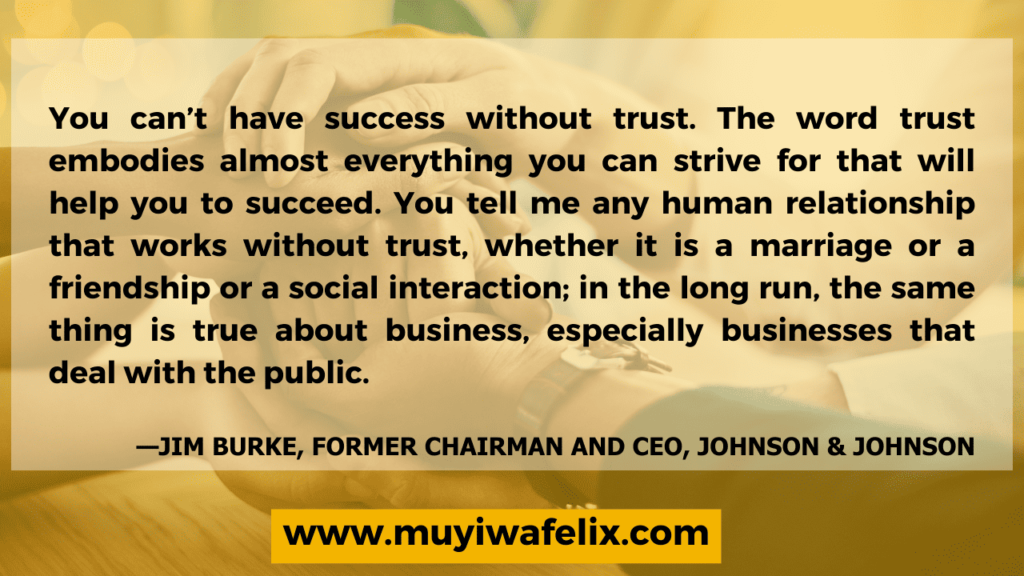
This section inspires the critical need for each person to think about their situation and ask some salient questions. Who do you trust? Why do you trust them and what particularly inspires confidence in that relationship?
After a deep thought on these questions, on the flip side, you should also ask yourself, Who trusts you? People at home? At work? Someone you’ve just met? Someone who has known you for a long time? What is it in you that inspires the trust of others?
If we can carefully and consciously answer these questions, it will inspire us to consciously uphold people’s trust in us.
When trust is lost, how do we regain it? Let’s break down the concept of trust a bit further
Trust is a function of two things: Character and Competence – The speed of trust
“Character includes your integrity, your motive, your intent with people. Competence includes your capabilities, your skills, your results, and your track record. And both are vital”
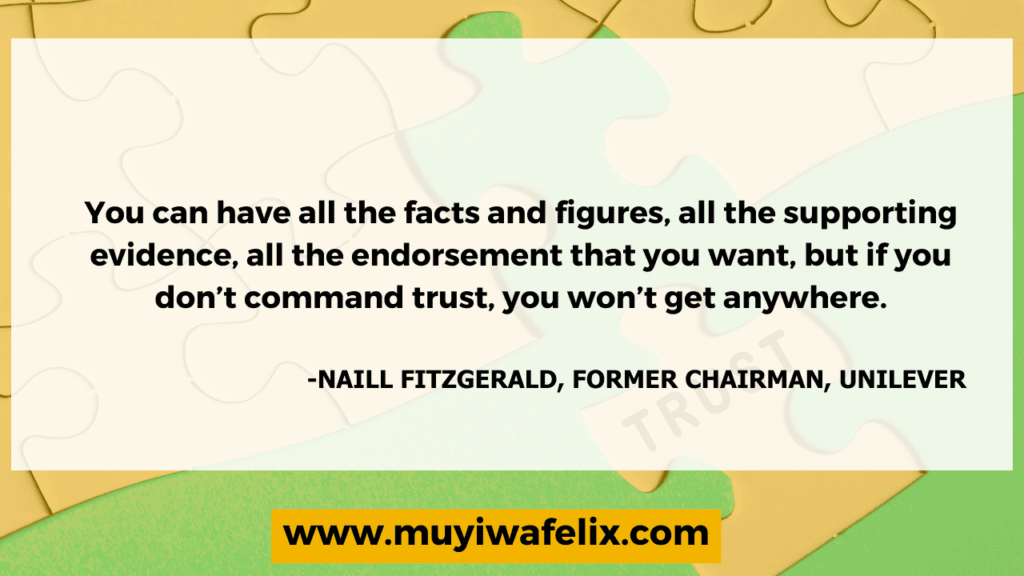
Character (The Speed of Trust Summary)
Good character is an essential element in any relationship. To be considered a trustworthy person, one must demonstrate honesty, respect, integrity, and dependability, as well as being reliable and consistent.
In the same vein, showing respect for others and having integrity in all your dealings will help to build trust and create a lasting bond with others.
Competence (The Speed of Trust Summary)
Trust also requires competence. In other words, good relationships are result-oriented. Being competent means having the skills, knowledge, and experience to do something successfully. Either in a formal or informal relationship, the person or people you are dealing with have to be able to trust that you are capable of completing the task or duties assigned to you. When others have faith in someone’s ability to get the job done right, it helps to build trust between them.
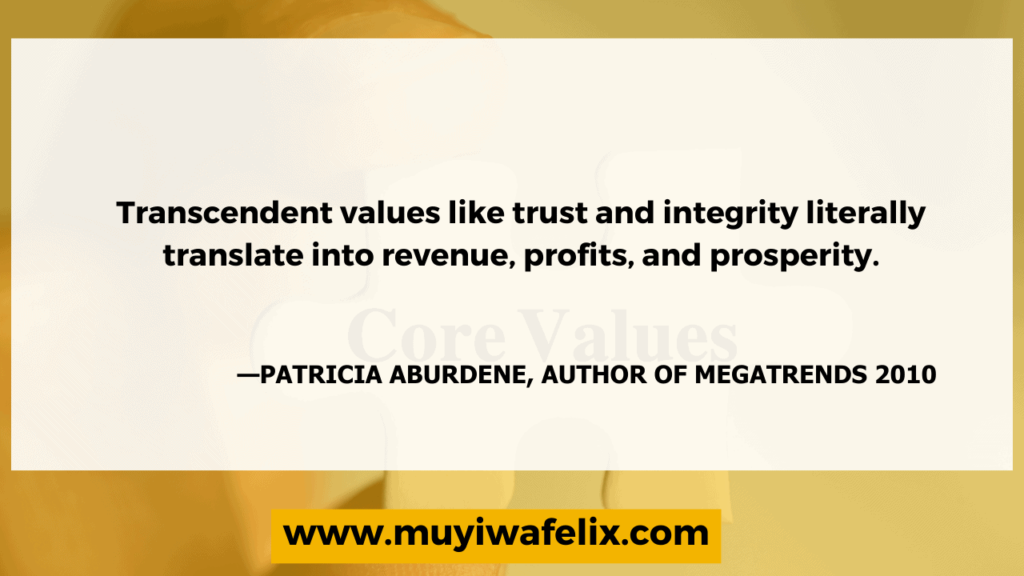
Once you realize the importance of these two factors, you will begin to see how the most effective leaders have wielded them efficiently.
These two words – Character and competence – even though may be expressed in other forms, are the structural unit of trust.
Stephen cited the statement of some great leaders
Warren Buffett—CEO of Berkshire Hathaway—prioritizes “integrity” (character) and “intelligence” (competence) as the qualities he looks for in people.
Jim Collins—author of Good to Great —talks about a Level 5 leader having “extreme personal humility” (character) and “intense professional will” (competence). InBuilt to Last, he speaks of the need to “preserve the core” (character) and “stimulate progress” (competence).
| MYTH | REALITY |
|---|---|
| Trust is soft | Trust is hard, real, and quantifiable. It measurably affects both speed and cost. |
| Trust is slow. | Nothing is as fast as the speed of trust. |
| Trust is built solely on integrity. | Trust is a function of both character (which includes integrity) and competence. |
| You either have trust or you don’t. | Trust can be both created and destroyed. |
| Once lost, trust cannot be restored | Though difficult, in most cases lost trust can be restored. |
| You can’t teach trust. | Trust can be effectively taught and learned, and it can become a leverageable, strategic advantage. |
| Trusting people is too risky. | Not trusting people is a greater risk. |
| Trust is established one person at a time. | Establishing trust with the one establishes trust with the many. |

The 5 waves of Trust – The speed of trust
Stephen used the metaphor of the ripple effect and an inside-out approach to address the subject of trust such that everyone can have a piece of it. He called it the 5 wave of trust and they are
- The first wave – Self-trust
- The second wave – Relationship trust
- The third wave – Organizational Trust
- The fourth and fifth waves – Market trust and Societal trust
The first wave – Self-trust (The Speed of trust)
Deals with the confidence we have in ourselves to achieve a goal, meet a need, and inspire others to do the same. This wave is built on credibility and Stephen indepthly explores the 4 cores of credibility as integrity, intent, capabilities, and result. The first two cores – Integrity and intent – are matters of character while the last two cores – capabilities and results are matters of competence.
As regards being credible to one’s self, you can do so by
- Setting achievable goals
- Be committed to your set goals
Integrity (The speed of trust)
This is the quality exhibited when you walk the talk. That is, you make a promise to yourself and you follow through in due time. To many people, integrity means honesty but it is a bit more than that. Integrity “is the courage to act in accordance to your values and beliefs”
Intent (The speed of trust)
Intent is the motive behind every decision and action. Intent defines our standpoint in any situation and determines how other people perceive our actions. “Trust” only “grows when our motives are straightforward and based on mutual benefit”, Stephen writes.
Capabilities (The speed of trust)
These are the abilities we possess in the form of skills, knowledge, talent, attitude, and style. These abilities when displayed at their optimum inspires confidence in us. For instance, a footballer might have good motives and integrity, but unless he is skilled enough to execute the plans of his coach on the field, he won’t be trusted with a place in the team.
Results (The speed of trust)
Trust is result-oriented. A good intent cannot erase bad judgment. To be trusted, our results have to speak for us, at least, to a certain degree. Results refer to our track record, our performances, our accomplishments, and our ability to make the right judgment.

The second wave – Relationship trust (The speed of trust)
In this wave, Stephen explores how to establish and increase the “trust accounts” we have with others. This wave is built on consistency in behavior. Stephen explores 13 key behaviors common to high-trust leaders around the world with the hopes that anyone can use them to boost Relationship Trust. As effective as these 13 behaviors, when wrongly used, overused, or harshly used, it gives the opposite result which is a breakdown of trust. The 13 key behaviors are highlighted below.

The first 5 behaviors are character-based. Here are they…
Behavior #1: Talk Straight (The speed of trust)
Communicate clearly, such that the intent of your message is not misunderstood. When “talking straight” is taken too far, the message might come off as being rude or insensitive. Describe and explain things with the right words without distorting facts or withholding the truth.
Behavior #2: Demonstrate Respect (The speed of trust)
Beyond talking, show people that you truly respect them. Let them know that you value their presence, time, and resources. In many cultures, people often think that respect should flow from the lesser person to the higher person e.g. Subordinate to a boss, children to parents, etc, but this is erroneous. Respect is horizontal, not vertical. Your subordinates deserve to be respected as much as your superiors. Here, Stephen used the Golden Rule to nail this point. Golden states “Do unto others, as you would have them do unto you”
Behavior #3: Create Transparency (The Speed of Trust)
This is basically resisting the temptation to keep secrets. Creating transparency means you are open and genuine, and you tell the truth in a way that can be fact-checked. It is based on the principles of honesty, openness, integrity, and authenticity. Transparency not only helps to establish trust, but it is also a very important tool in rebuilding and regaining trust where it has been lost. Don’t hide information. Operate on the principle of “what you see is what you get”.
Behavior #4: Right Wrongs (The Speed of Trust)
What’s wrong than being wrong is being obstinate in error. If you discover that a wrong has been done, do well to acknowledge it and take intentional steps to right your wrongs. This is more than just apologizing, it is restitution. An apology must be backed with the intentionality to correct the wrongs and correct future occurrences.
This behavior is founded on the principle of humility, integrity, and restitution. The opposite of “righting wrongs” is to deny or justify wrongdoings or fail to admit mistakes until forced to do so. In this opposite situation, such a person is more humbled by circumstance than by conscience. To achieve success with this behavior, you can’t let pride or ego come in the way. Reject the benefits of your wrongdoing and let reparation begin.

The next 5 behaviors are competence-based. Here they are:
Behavior #5: Show Loyalty (The Speed of Trust)
Showing loyalty is one effective way to build trust with people. It is based on the principle of integrity, loyalty, gratitude, and recognition. Stephen recommends two dimensions by which one can show loyalty
- Giving Credit to Others – Giving credit to others means acknowledging the contribution of others for their part in the result achieved. This not only breeds a positive environment for people to thrive individually but also encourages team spirit and creates an atmosphere where people freely share ideas. The opposite of this behavior is taking credit for yourself.
- Speaking about people as though they were present – Communication is very essential in every relationship. You should never say behind someone what you wouldn’t have the courage to say in their presence. You must ensure that situations don’t drag you into gossiping and backbiting. Speaking about people as though they are present is founded on the principle of intent. If you have to discuss someone, let it be with the intent of making them better The opposite of this behavior is sweet-talking people to their faces and bad-mouthing them behind their backs. That’s just as bad!
Behavior #6: Deliver Results (The Speed of Trust)
Trust is essentially based on your ability to deliver the results you promised. If results don’t back up the talks and efforts, then it is a huge withdrawal on the “trust account”. On the competence side, delivering results can help convert your doubters to fans, establish trust very fast in a new relationship, and regain trust where it’s been previously lost.
To ensure the effectiveness of this behavior, it is necessary to manage expectations. There are situations where people felt they have delivered results but didn’t get the expected reaction. In most cases like this, it is because the expectation was not managed upfront. A popular phrase among business people is “underpromise and overdeliver”. When you give a relatively low expectation, you can easily meet and surpass your client’s expectations. Doing the opposite is often detrimental to trust.
Behavior #7: Get Better (The Speed of Trust)
Getting better is built on the principle of continuous improvement, learning, flexibility, and change. Everyone loves growth. When people see that you are a learning, flexible, and growing person or organization, they are inspired to develop confidence in the ability of the individual or organization to succeed in a rapidly changing environment. The opposite of this behavior is complacency, living on old glory and hereby losing the ability to cope with developing situations. Stephen highlights two counterfeits of getting better. They are
- The eternal student phenomenon – people who perpetually learn without doing and
- The “You must know what I know” phenomenon – People who project their strength on everyone’s weaknesses.
In any relationship or association, getting better involves seeking feedback and learning from mistakes.

Behavior #8: Confront Reality (The Speed of Trust)
This is about the courage to have tough discussions, address issues as they should, share the news in its genuineness, etc. This behavior is founded on the principles of responsibility, courage, awareness, and respect. When you open up and confront reality, it fosters an atmosphere for open interaction, and rather than face the challenges alone, this behavior helps others (your team, friend, spouse) to get involved and engage their creativity and capabilities.
Lead difficult conversations courageously; read the room and vocalize the unsaid; don’t pass the ball when the conversation is tough and don’t bury your head in the sand while you have these discussions.
Behavior #9: Clarify Expectations (The Speed of Trust)
This entails defining expectations upfront. Stephen calls it the behavior of prevention as it prevents conflicts that ensue from unmet expectations. To safely define expectations, Stephen suggests quantifying everything: What result? By whom? When? At what cost? What are the deliverables? What are the achievement indicators?
This behavior is based on the principle of clarity, responsibility, and accountability. The opposite of this is assuming that everyone knows the expectation when it’s not been clearly defined. This leaves everyone guessing and might make a huge withdrawal from the trust account.
Behavior #10: Practice Accountability (The Speed of Trust)
When expectations are clarified, it is easier to be accountable. There are two key dimensions to practicing accountability. The first step here is self-accountability i.e. holding yourself accountable and secondly, holding others accountable. You can’t be effectively accountable to anyone if you’re not accountable to yourself.
In the same vein, it is almost impossible to hold anyone accountable if you’re not accountable to yourself. This behavior is founded on the principles of accountability, responsibility, stewardship, and ownership. Leaders who effectively practice this behavior lead by doing. They roll their sleeve and lead the way!

The final 3 behavior requires an equal blend of character and competence.
Behavior #11: Listen First (The Speed of Trust)
Listening here means listening before you speak and listening to understand. It is genuinely seeking to understand another person’s thoughts from their perspective, not yours. It is totally different from listening to respond which unfortunately is what most people do. This behavior is built on the principle of understanding, respect, and mutual benefit. The opposite of this behavior is to pretend to be listening while you really aren’t.
Behavior #12: Keep Commitments (The Speed of Trust)
Keeping commitment is the fastest way to build trust in a relationship – starting with yourself, your friends, parents, spouse, boss, customers, etc. If you can’t keep a commitment to yourself, you can’t efficiently keep commitments to someone else. The opposite of this behavior is “breaking promises”. Making commitments builds hope, when you keep it, you build trust. Make commitments carefully and keep them diligently.
Behavior #13: Extend Trust (The Speed of Trust)
Extending trust is the propensity to believe in other people’s ability to complete a task successfully. While other behavior helps you earn the trust of others, “extending trust” helps you build trust in others and leverage it. People give their best when they feel trusted by a respected superior. It is a very powerful tool in leadership that you can trust your subordinates/team and make them feel trusted.
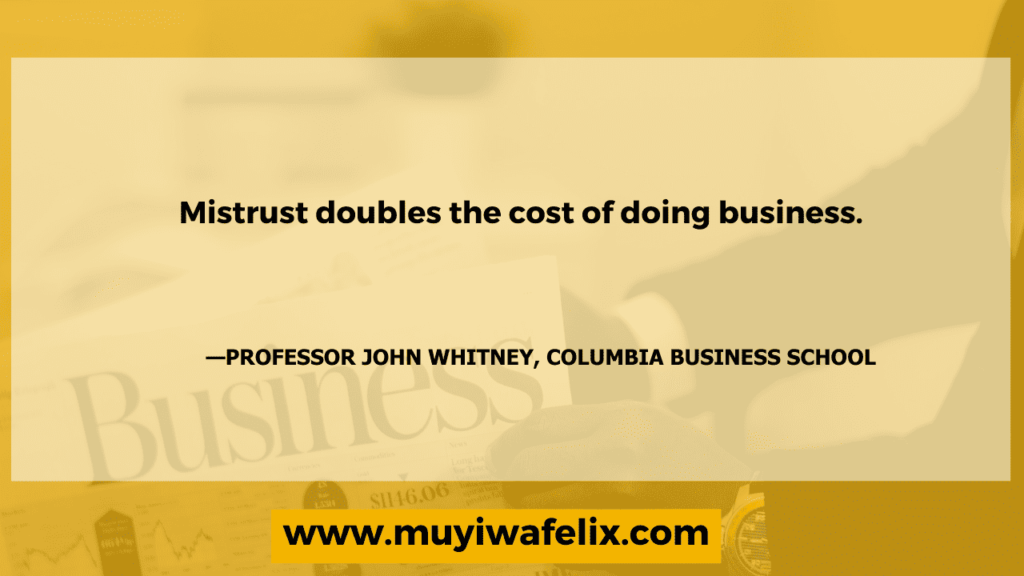
The third wave – Organizational Trust (The Speed of Trust)
This wave deals with how leaders can build trust in organizations such as businesses, not-for-profit organizations, families, etc This wave is built on alignment which Stephen explains could help build structures, systems, and organizational trusts that eliminate 7 insidious organizational trust taxes and in turn creates 7 organizational trust dividends. The knowledge shared here helps establish trust with internal shareholders and is based on the principle of alignment.
In simple words, alignment here implies the creation of an organizational system built on coherent and consistent character and competence scaled to the organizational level. The 4 fundamental cores of trust – integrity, intent, capabilities, and results are still highly operational here. To inspire Organizational change, ask yourself questions that border around these 4 cores of trust.
- Integrity – Does my organization have integrity? Are our methods lawful? Do we have a culture of honesty?
- Intent – Does my organization have good intent? Are we truly interested in solving people’s problems? Do we truly care for one another, our customers?
- Capabilities – Do we have the right personnel to deliver our service or products? Are we continuously improving and innovating?
- Results – Does my organization get results? Are our products and services delivering the promised value? Does our track record promote confidence? Do we get client referrals?
Unfortunately as a leader, you may have successfully built self-trust and relationship trust such that people trust you as a person but fail at organizational trust level by not designing and aligning systems that create trust.
In the practical sense, the following may be needed
- Recruitment – Employing the right personnel for the right duties
- Team building – Including the personnel with the right skill set in the right team
- Development – Creating genuine career development training for staff
- Remuneration – Paying staff salaries and wages in due time and amounts equivalent to skillset and task completed
- Organizational Structure – Defining company mission, vision, the cadre of authority, and leadership
In situations where trust is low in an organization, an effort must be made to rebuild trust based on these fundamentals. Here are 7 low trust organizational taxes and 7 high trust organizational dividends. (Remember that taxes and dividends are used contextually)
7 Low Trust Organizational Taxes
- Redundancy – Unnecessary duplication of effort
- Bureaucracy – Complex and cumbersome organizational processes and systems
- Politics – This may include favoritism, seeking undue credit, using unfair tactics and strategies to gain power
- Disengagement – This occurs when people are no longer committed to their jobs. They are physically present but not with their hearts and minds. They do the basic minimum to earn their paychecks
- Turnovers – In low-trust work environments, the high performers there tend to quit and move to organizations where they are trusted. Turnover is a huge cost to any organization.
- Churn – This is the turnover of external stakeholders like customers, shareholders, investors, etc.
- Fraud – Every form of dishonesty, sabotage, obstruction, disruption, and deception. Fraud can be connected to any of the first 6 mentioned.
7 High Trust Organizational Taxes
- Increased Value – High trust increases shareholder and customer value
- Accelerated Growth – High-trust companies are often industry benchmarks. They outperform low-trust organizations
- Enhanced Innovation – Because they are constantly learning, they have a strong culture of coping with changes and innovating.
- Improved Collaboration – HIgh trust company environment relegates competition and promotes collaboration and team spirit necessary for achieving results
- Stronger partnering – It is easier for two high-trust companies to collaborate and explore new grounds than otherwise
- Better Execution – Based on the principle of alignment, project execution is swifter in high-trust environments.
- Heightened Loyalty – Both external and internal stakeholders find it easier to trust and stay loyal to high-trust companies.

The fourth wave – Market Trust (The Speed of Trust)
This wave deals with the perception of people about your company brand; their ability to trust your product and services. This wave is built on “reputation”. It reflects the trust external stakeholders (investors, customers, suppliers) have in your business or brand. When your brand is seen or mentioned in the public, what comes to mind first? This level of trust is also built on the fundamentals already defined above for self-trust (4 cores), relationship trust (13 behaviors), and organizational trust.
The fifth wave – Societal Trust (The Speed of Trust)
This wave is about creating value for society at large. It is based on the principle of contribution. Every business needs a defined space to operate and thrive. That space, either online or offline, is within a society whose trust every business needs.
The principle of contribution is the intent to create value instead of destroying, giving back instead of taking. Societal trust is earned through every effort or contribution of an individual or business to the general public.

How do you build trust as a small business owner?
The following should be done to ensure that you build trust in your small business.
- Deliver what you promise: Let your results match your words. Show your customers that they can count on you to follow through on your promises. It is best that you underpromise and overdeliver.
- Be transparent and honest: Being honest and upfront about your business’s operations and intentions will help create trust. Keep an open line of communication between you and your stakeholders (Workers, Customers, Suppliers, Regulating Agencies)
- Listen to customer feedback: Paying attention to the reviews and feedback from your customers will help you understand what they need and want so that you can make the necessary improvements.
- Provide quality services: Make sure that the services and products you provide are of good quality so that your customers can trust that they are getting what they are paying for.
- Show appreciation: Make your customers feel valued by expressing gratitude for their business.
- Respond promptly: Make sure you respond to customers in a timely manner so that they know their concerns are taken seriously.
- Invite customers to provide suggestions: Involve your customers in creating new products and services, or brainstorming different ways to improve your business. This will show them that you value their input and that you trust their instincts.
- Develop relationships: Take the time to get to know your customers on a more personal level based on the second wave of trust herein discussed. This will help build trust and let them know that they can come to you with any concerns or questions.
The speed of trust quotes
You can’t have success without trust. The word trust embodies almost everything you can strive for that will help you to succeed. You tell me any human relationship that works without trust, whether it is a marriage or a friendship, or a social interaction; in the long run, the same thing is true about business, especially businesses that deal with the public.
—JIM BURKE, FORMER CHAIRMAN AND CEO, JOHNSON & JOHNSON
You can have all the facts and figures, all the supporting evidence, and all the endorsement that you want, but if you don’t command trust, you won’t get anywhere.
— NAILL FITZGERALD, FORMER CHAIRMAN, UNILEVER
The moment there is suspicion about a person’s motives, everything he does becomes tainted.
—MAHATMA GANDHI
Whether you’re on a sports team, in an office, or a member of a family, if you can’t trust one another there’s going to be trouble.
—JOE PATERNO, HEAD FOOTBALL COACH, PENN STATE UNIVERSITY
Transcendent values like trust and integrity literally translate into revenue, profits, and prosperity.
—PATRICIA ABURDENE, AUTHOR OF MEGATRENDS 2010
Mistrust doubles the cost of doing business.
— PROFESSOR JOHN WHITNEY, COLUMBIA BUSINESS SCHOOL
Trust is absolutely key to long-term success.
—JIM BURKE, FORMER CHAIRMAN AND CEO, JOHNSON & JOHNSON
Leadership may have to come in a different package. It’s got to be credible…. Overall, it’s about credibility, walking the talk.
—ANNE MULCAHY, CHAIRMAN AND CEO, XEROX
Little things count. Like when someone calls in to talk to a manager and his assistant says he is in a meeting when he is not. It’s the little things that your employees notice.
—FRANK VANDERSLOOT, PRESIDENT AND CEO OF MELALEUCA
You cannot prevent a major catastrophe, but you can build an organization that is battle-ready, that has high morale, that knows how to behave, that trusts itself, and where people trust one another. In military training, the first rule is to instill soldiers with trust in their officers, because without trust they won’t fight.
—PETER DRUCKER
A good leader is probably no different in any culture in the sense that a good leader must have credibility. That is something one establishes… based on the way one handles himself and by his established track record.
—DR. VICTORK. FUNG, GROUP CHAIRMAN, LI & FUNG
Leadership without mutual trust is a contradiction in terms.
—WARREN BENNIS, AUTHOR OF ON BECOMING A LEADER
Trust men and they will be true to you; treat them greatly and they will show themselves great.
— RALPH WALDO EMERSON
Conclusion
After Reading The Speed of Trust by Stephen Covey, here are my takeaways
The speed of trust fundamentally starts with each individual and everyone has a role to play in building trust with ourselves with others.
Relationships that are low on trust are redeemable with careful strategies and conscious intentional acts that genuinely create a positive atmosphere for all stakeholders.
The 13 behaviors recommended for best practices in relationships have recorded empirical results for renowned leaders across different organizations and sectors. If anyone employs them appropriately, they will yield positive results.
The principles needed for self-trust and relationship trust are the same principles fundamentally needed for Organizational, market, and societal trust. However, their application at higher levels needs to be scaled.
While the subject of trust could easily seem sensational, Stephen was conscious to explore the downsides of a low level of trust.

Ogunjobi Oluwamuyiwa Felix preferred to be called Muyiwa Felix, is a personal finance coach and Insurance advisor. He creates content that addresses the core of personal finance in Canada, the United States, and the world at large. Daily, he meets up with clients who are interested in financial risk management, income protection, wealth-building, retirement planning, and tax-efficient investing strategies.
